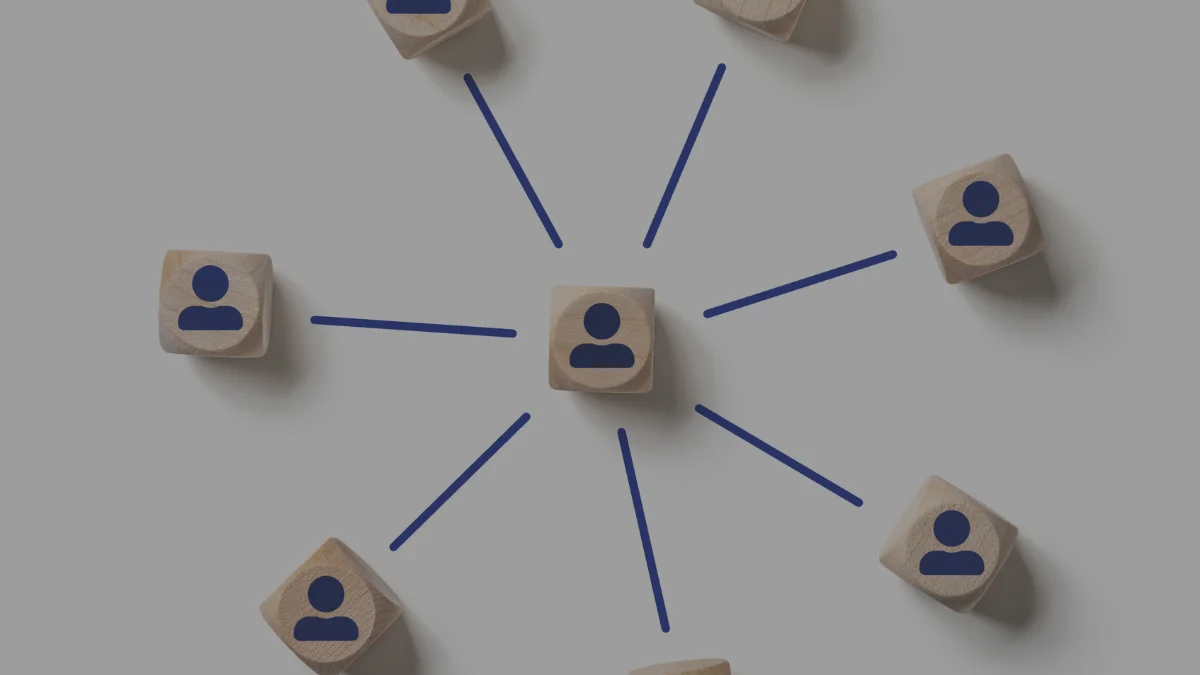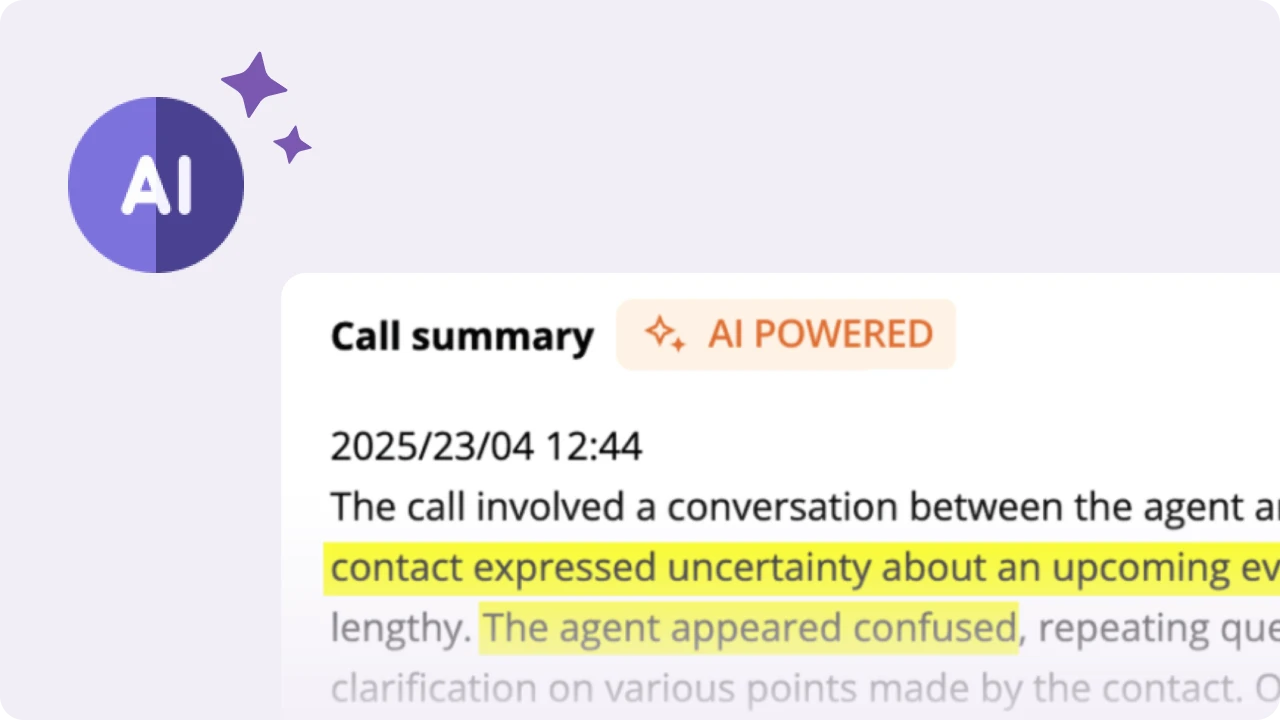Table of Contents
Imagine if every volunteer could personally reach 100 voters — not cold calls, but trusted friends or acquaintances. That’s the power of relational organizing: leveraging existing connections to turn out the vote, raise funds, and mobilize communities. Unlike traditional canvassing, this approach is built on existing trust, making every interaction more personal and persuasive.
And that’s what helped Georgia’s 2021 Senate runoffs.
Jon Ossoff’s campaign used relational organizing to flip the state. Nearly 2,800 Georgians were hired to engage their personal networks, ultimately reaching 160,000 voters and boosting turnout by 3.8 percentage points

That kind of impact leads to more campaigns integrating relational organizing. So, here is what you will learn about relational organizing in this blog:
- Why relational organizing works (with data to back it)
- Top tools to launch a relational organizing campaign
- Common challenges faced by campaign managers
- Best practices to get the most out of your efforts
Why relational organizing works?
By now, we know how powerful relational organizing can be. But why does it actually work? The answer lies in human connection. Let’s see how:
- Warm contacts win over cold contacts
Messages from friends and known contacts carry real weight. In fact, 83% of people trust a cause more when it’s recommended by someone they know, not by a stranger or ad. That same trust translates directly into action—whether you’re running a GOTV campaign, fueling community organizing, or even recruiting donors for your nonprofit.
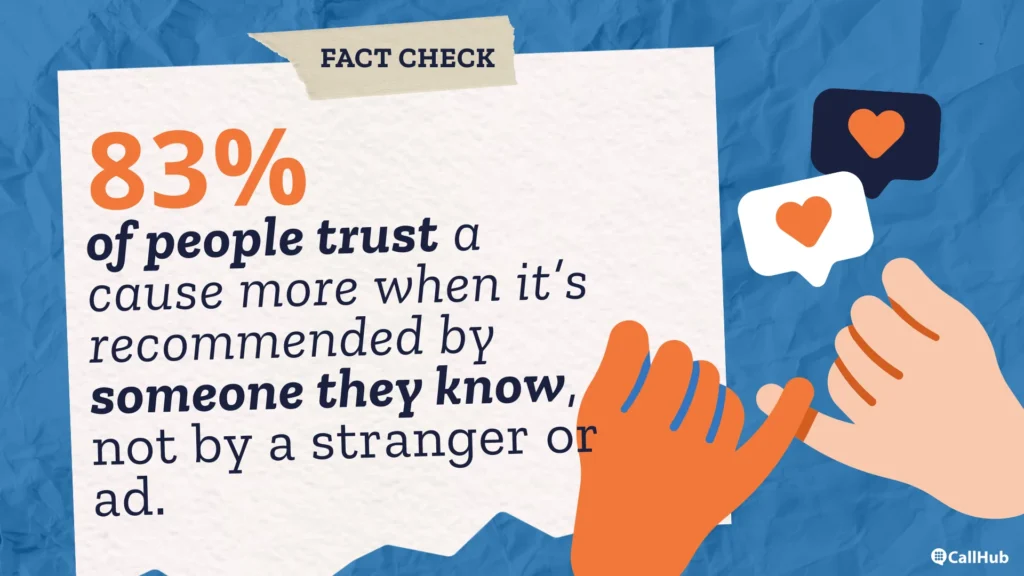
When a friend reaches out to remind you to vote, donate, or attend an event, it feels personal—not like spam. And that emotional connection makes all the difference.
- Personal, credible messaging
Each communication originates from a real relationship. Volunteers often share relational organizing examples from their own experiences, which makes their outreach more believable and relevant. For instance, a volunteer texting a school friend might say:
“Hey, I just signed up to help with the local GOTV campaign. When I spoke with the candidate recently, she explained how they are planning to invest in renewable energy jobs right here in our community—something I know we both care about. Don’t you think it’s the right person to support?”
Because the message comes from someone the recipient knows and trusts, it’s far more likely to gain a response than a mass text or cold call ever would.
- Real uplift in turnout
A 2020 study by political scientist Donald Green found that voters contacted by a friend were 13.2% more likely to vote than those approached by strangers. That’s a massive lift—especially when compared to:
- Traditional canvassing with 2–3% turnout lift
- Mass texts or cold calls with ~1% or less lift
When it comes to engagement, nothing beats a message from someone you already know.
- Builds community
Relational organizing goes beyond just turning out supporters. It builds real, lasting connections with your community. Volunteers stay engaged because they’re part of something personal and meaningful. Each supporter becomes a community node, sparking conversations and strengthening grassroots power over time.
With CallHub Community, you can build a space where organizers share ideas, tools, and inspiration, and discover new volunteer opportunities in politics, nonprofits, and advocacy. Organizations can also connect with passionate supporters ready to take action.
When you combine the power of real connections with the right tools, that’s when things really start to click.
Also read: 5 Tested Community Engagement Strategies For Successful Social Change
Top relational organizing tools for success
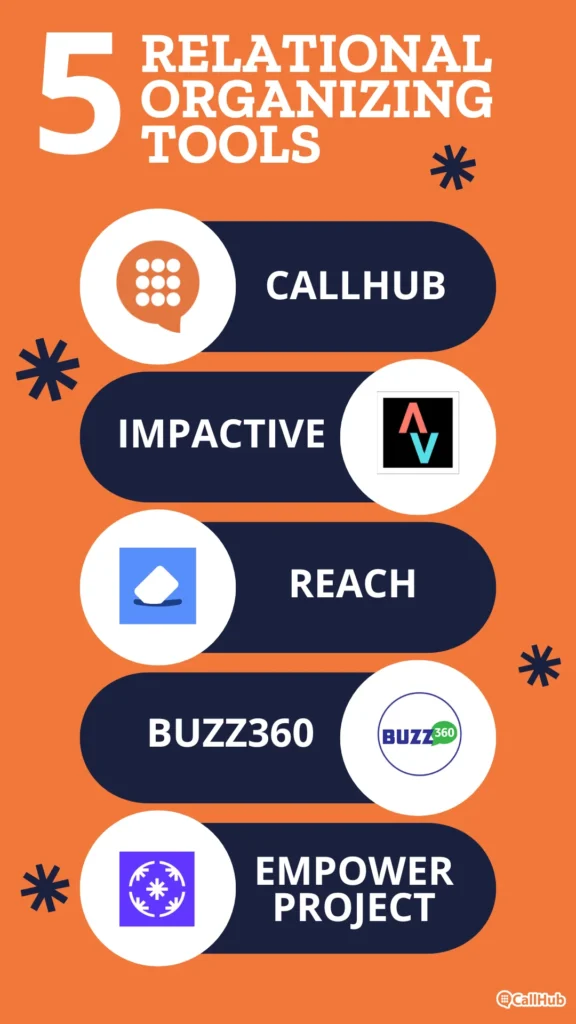
Relational organizing isn’t new. People practiced it by physically showing up in their communities—talking to friends, family, neighbors, and faith groups to drive change. Let’s see an example from the 1900s
Freedom Summer, 1964
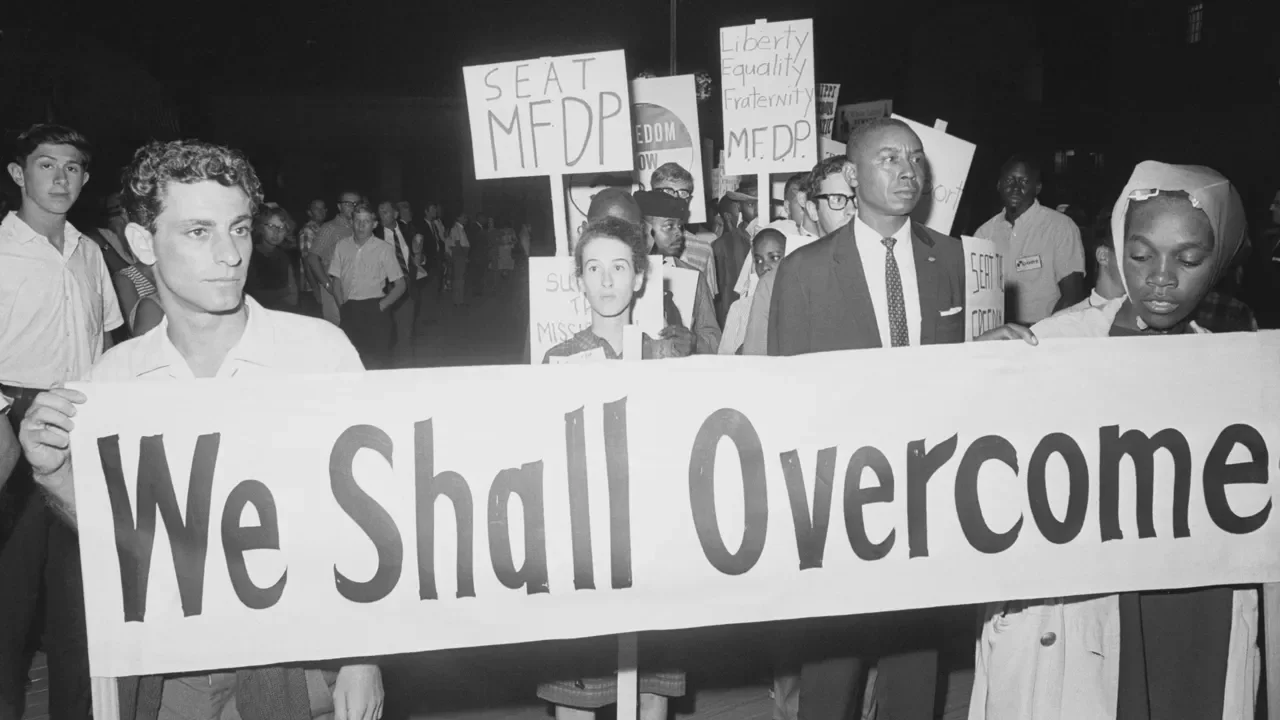
The issue:
In 1964, Mississippi had one of the lowest rates of black voter registration due to intimidation, discriminatory laws, and systemic suppression.
Approach taken:
Civil rights organizations launched the
“Freedom Summer” campaign.
During this campaign, civil rights volunteers went door-to-door in black neighborhoods, building trust through personal conversations to register voters and expand access to the ballot box.
The results:
Despite harassment and violence, the campaign successfully registered nearly 17,000 black voters, proving that trust-based, personal outreach could break through institutional barriers.
What’s new today is the technology—digital tools now allow campaigns to scale this trusted with speed, precision, and data-driven strategies. Let’s look at the top platforms making that happen:
1. CallHub
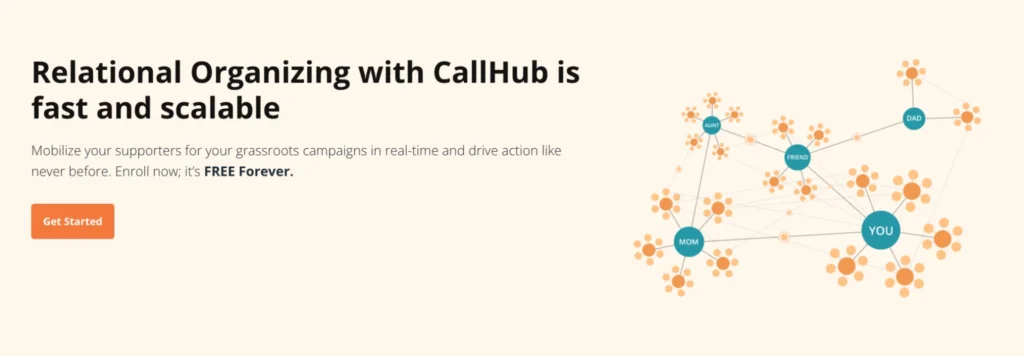
CallHub extends your base text/calling suite into mobile-first relational organizing outreach. Empowering volunteers to connect with their personal networks via various modes in one seamless flow.
Key features:
- Multi-modal outreach with texts, calls, social media DM, follow-ups
- The volunteer app is available both on Android and iOS, with multilingual support
- Scripts with survey questions and merge tags
- Volunteer and supporters’ information protected
- Automatic contact matching
- Real-time analytics and actionable insights
- CRM integrations like NGPVan, National Builder, Salesforce, etc..
Ideal for: Campaigns that need quick onboarding, multi-channel outreach (phone, SMS, and social media), and robust privacy controls.
Pricing: Enroll with CallHub now, it’s FREE forever!
Read also: Multilingual Voter Outreach Made Simple with CallHub.
2. Impactive
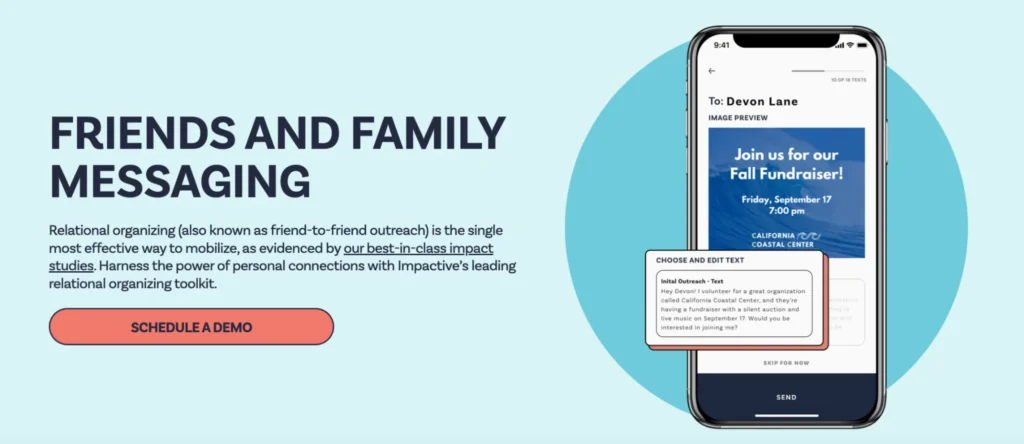
Impactive’s friends and family messaging is a digital organizing tool where relational outreach is built into their core suite
Key features:
- Support for outreach via SMS, email, and social DM
- Voter segmentation by voting history with multimedia support
- Supports multiple CRM integrations
- Offers multilingual support
Ideal for: Large-scale GOTV or advocacy campaigns already using established CRMs and seeking rich relational outreach.
Pricing: Starts with $50 per month. Visit their pricing page for more details.
3. Reach
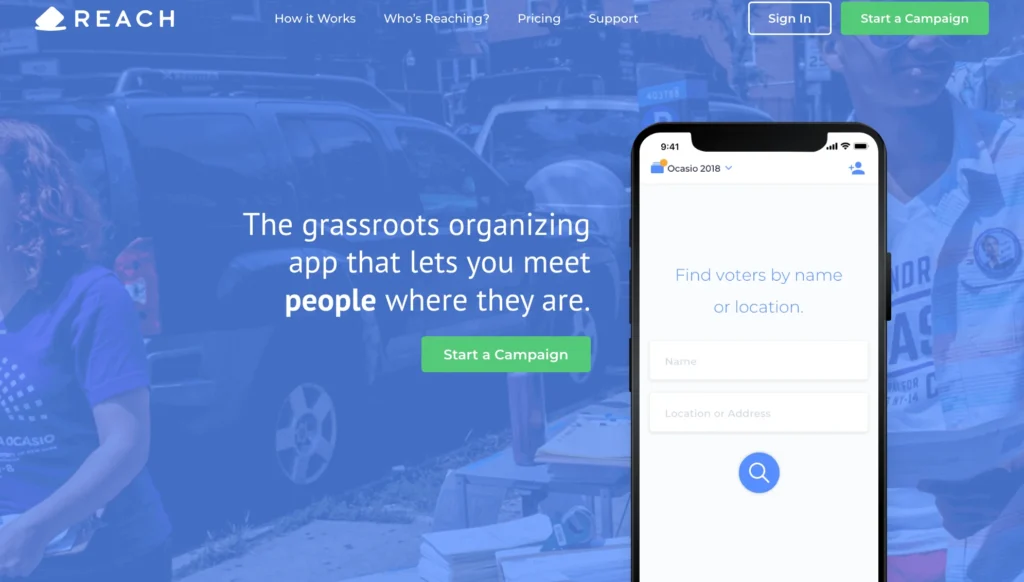
Reach’s relational organizing is a hybrid tool combining field canvassing and relational outreach, optimized for distributed volunteer organizing.
Key features:
- Import contacts and match to create a personal contact list
- “Action Cards” for easy texting and calling.
- Event feeds, push alerts, gamified dashboards, supporter chat groups
- API integration with smart tags
Ideal for: Campaigns combining both offline canvassing and digital organizing outreach in a mobile-native platform.
Pricing: They offer prices based on your target audience. Visit the pricing page for more information.
4. Buzz360
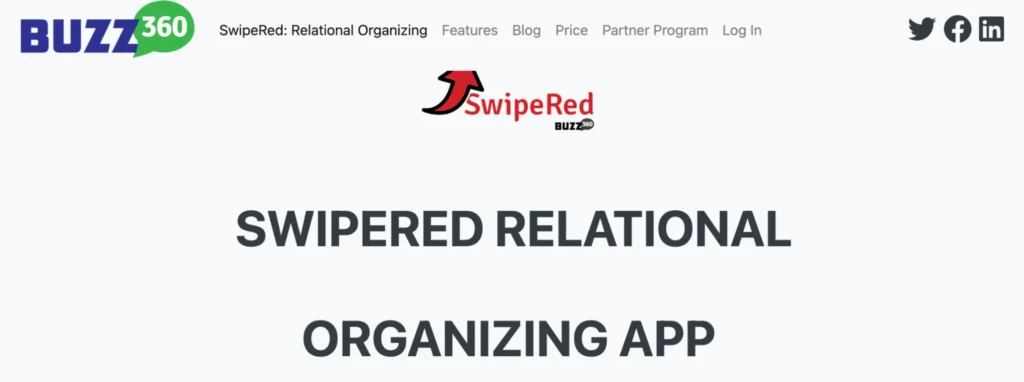
Buzz360’s relational organizing is an all-in-one campaign software combining relational organizing with GOTV, SMS/email, and voter contact tools.
Key features:
- SwipeRed™ friend-to-friend messaging app
- Share resources with volunteers, including talking points and FAQs.
- Run surveys via volunteers
- Neighborhood-based or location-targeted outreach
- Custom tags for targeting
Ideal for: Campaigns seeking a relational organizing tool that includes survey and internal voter feedback mechanisms.
Pricing: Buzz360 offers three packages: Essential, Pro, and Enterprise. Visit their pricing page for a detailed breakup.
5. Empower project
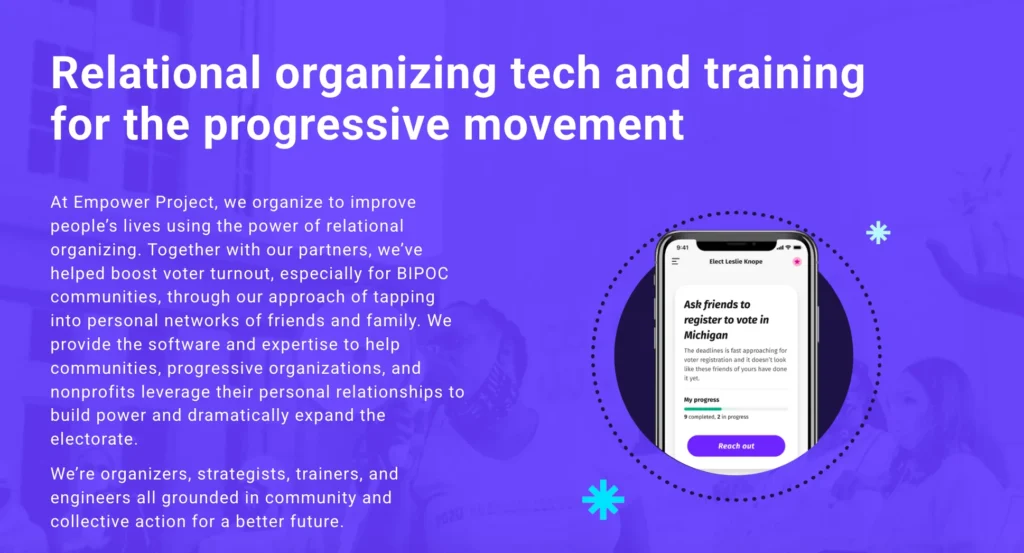
Empower project’s relational organizing is a mission-driven platform offering tools for nonprofits, unions, and affordable campaigns, alongside training.
Key features:
- All-in-one app for volunteers, with multilingual support
- Supports calls, texts, and social media
- Integration with major CRMs, such as NGP VAN and EveryAction.
- Real‑time dashboards with gamification
- Offers 1:1, customizable training to organizations.
Ideal for: Campaigns aiming to kickstart relational organizing on a budget with built-in support and education.
Pricing: Schedule a meeting with them via Calendly to discuss the pricing.
But even with the right tools in hand, running a successful relational organizing campaign isn’t without its hurdles. What are those? Let’s find out..
What are the challenges with relational organizing?
When it comes to relational organizing, even seasoned campaigns and nonprofits run into challenges—knowing them upfront is how you set up your effort for success. Common stumbling blocks are listed below, along with solutions you can implement:
1. Making the wrong ask
Volunteers may unintentionally pitch an ineffective or inappropriate ask—like a donation request that’s too high or asking someone to host a campaign event, which they are not comfortable with. When that happens, supporters often say “no,” closing the door on future conversation.
Solution: Educate volunteers using relational organizing tools to research their personal network, understand what each connection is capable of or interested in, and tailor the ask. There’s no universal script—each ask must be contextually smart, data-informed, and culturally sensitive.
Also read: Guide Call Center Agents to the Right Questions with Branching Scripts on CallHub.
2. Expectation of hearing from the candidate
In down‑ballot or local races, voters often expect or prefer to hear directly from the candidate rather than through a volunteer. They want to understand why the candidate supports a policy or what personal connection they have.
Solution: Often, the need to hear from the candidate stems from wanting to understand the candidate’s story. Questions like:
- Why does the candidate so strongly vouch for this policy?
- What is the candidate’s take on a specific issue?
In those cases, the volunteer who is reaching out to them can share their own story (and why they support the candidate/party).
With CallHub, your volunteers can share their stories not just through calls or messages, but also across social media.
They can post scripts on platforms like WhatsApp, Instagram, or Facebook—by adding a personal touch to it while staying aligned with the campaign message.

3. Organizational challenge
Turf war. Sometimes, a volunteer’s network doesn’t live in the area they’re assigned to. This can cause confusion or overlap between different organizers—leading to duplicated efforts or turf issues.
Solution: As Alinsky, the famous American activist, writes:
“A sense of humor,” allows the organizer “to maintain his perspective and see himself for what he really is: a bit of dust that burns for a fleeting second.”
In short, don’t get too caught up in boundaries. Come up with ways to manage and track cross-turf. Traditional segmentation of geographic turf may no longer be the best way to organize your campaign. So, you can focus on mapping out the super-volunteers and potential influencers in your geographic area based on their sphere of influence.
These challenges do not mean relational organizing won’t work for your campaign. It merely means that you should watch out for (and plan) for the above scenario so that your campaign runs smoothly.
Best practices for relational organizing campaign success
To build a winning campaign fueled by personal connections, it’s not enough to simply tell supporters to “text their friends.” Effective relational organizing demands structure, planning, and the proper support. Here are six best practices that avoid pitfalls and help to gain maximum support:
| Best practice | Why does it matter? |
| Start early & plan methodically. | Relational programs thrive with time. Start mapping your supporter network months ahead of GOTV or big push to give volunteers time to build genuine conversations. |
| Map your network strategically. | Use relational organizing tools or a relational database to find people in important areas (like swing districts) or key communities where outreach can make a big difference for targeted outreach. |
| Recruit & empower influencers. | Find trusted individuals in the community—such as professors or local leaders—who can effectively spread the word to others. This is key for canvassing and building momentum. |
| Make storytelling core to outreach. | People connect with stories. Ask volunteers to share why they support the cause and use real relational organizing examples to inspire action. |
| Listen, personalize, and follow u. | Real digital organizing isn’t once-and-done. Volunteers should be trained to listen, follow up, and tailor messages for impact. |
| Use tech to track & scale. | Tools like CallHub help track conversations, tag actions, and coordinate across teams—essential for scaling success. |
Scaling impact together with relational organizing
Here is a fun fact: Did you know that relational organizing is called by many names? As Marshall Ganz mentioned:
“Some call this framework the snowflake model, others distributed leadership, and still others the Ganz model.”
But whatever you call it, it’s rooted in decades of community organizing and built to scale people’s power through trusted networks. With CallHub’s relational organizing, you can easily mobilize volunteers, track conversations, and scale that trusted outreach. All from one simple, user-friendly platform, which is completely FREE!!
Sign in with CallHub and start getting more support via your networks.
